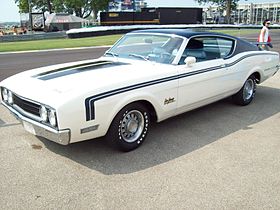Mercury Cyclone Spoiler II
| Mercury Cyclone Spoiler II | |
|---|---|
 |
|
| Overview | |
| Manufacturer | Mercury (Ford) |
| Also called | Ford Torino Talladega |
| Production | 1969 |
| Model years | 1969 |
| Body and chassis | |
| Class | Race car/Muscle Car |
| Body style | 2-door hardtop fastback |
| Layout | FR layout |
The Mercury Cyclone Spoiler II is a muscle car that was produced by Mercury in early 1969. The Mercury Cyclone Spoiler II was a special, more aerodynamic version of the Mercury Cyclone. It was produced specifically to make Mercury even more competitive in NASCAR stock car racing, and was sold to the public only because homologation rules required a minimum number of cars (500 in 1969) be produced and made available for sale to the public. All production examples were constructed during the first few weeks of 1969.
The Mercury Cyclone Spoiler II was built in only two trim packages: The Cale Yarborough Special - a white car with red interior and exterior trim, and the Dan Gurney Special - a white car with blue interior and trim.
A largely equivalent vehicle was also produced under the Ford marque as the Ford Torino Talladega.
The 1969 Mercury Cyclone Spoiler II was based on the Mercury Cyclone "Sportsroof" (Ford's trade name for a fastback) 2-door hardtop. To make the car more aerodynamic at high speeds, a sleeker front section was added. Regular production Mercury Cyclones had a then-fashionable inset grille and headlights, which fared poorly in the wind tunnel. The Mercury Cyclone Spoiler II had this nose replaced with one that extended the car's length by about six inches, with a flush-mounted grille from a Ford Cobra, identical to the grill used on the Ford Torino Talladega giving it a much more aerodynamic front end. The close-fitting bumper was actually a rear bumper from a 1969 Ford Fairlane that had been cut, narrowed, V'ed in the center, and filled on the ends to create a crude air dam, further improving the aerodynamics of the car at high speeds. In a well kept, secret design move, the rocker panels were reshaped and rolled to allow Mercury teams to run their racing cars about an inch closer to the ground while staying within NASCAR rules; this also greatly enhanced the top speed of the car by lowering its center of gravity, and further reducing its wind resistance. All production (homologation) models of the Mercury Cyclone Spoiler II were equipped with a 351 Windsor engine, automatic on the column, and front bench seat.
Racing versions of the car were initially fitted with the Ford FE 427 side oiler engine that had been Ford's main racing engine since 1963. Later in the season, the Boss 429 engine was used by many of the teams, after it had finally been declared "officially homologated" by NASCAR president, Bill France. Ironically the Boss 429 engine was actually homologated in the 1969 Ford Mustang Boss 429. In a very unusual move, Ford homologated the engine separately from the car in which it was to race. Many experts think this may have been done in order to get the bodywork of the Mercury Cyclone Spoiler II officially homologated at the beginning of the 1969 race season, as the Boss 429 was not yet in production in sufficient numbers to homologate it.
...
Wikipedia
